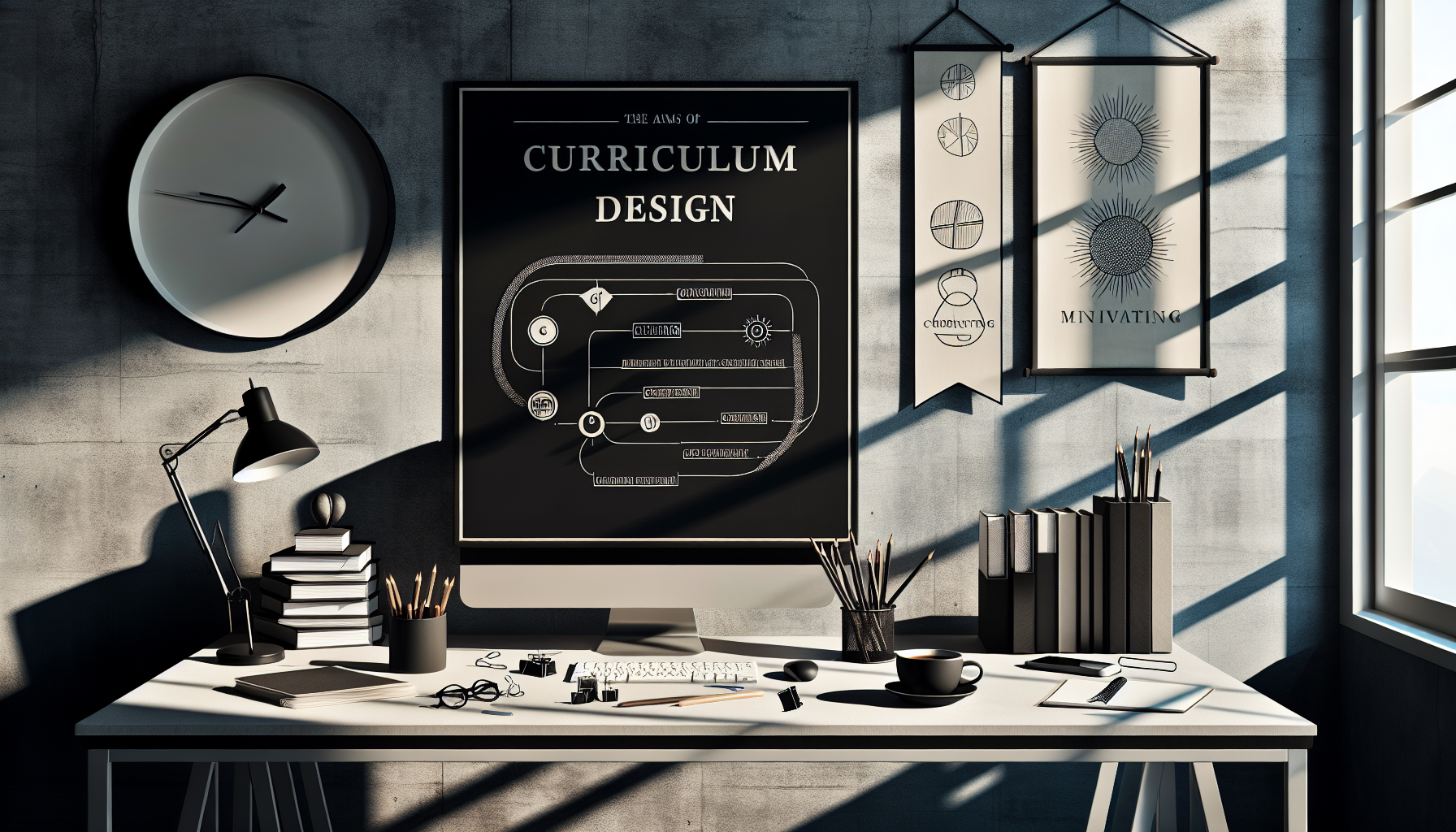Creating a curriculum can feel overwhelming, right? The pressure to meet diverse learner needs while making the content engaging often leaves you unsure of where to start. You’re definitely not alone in thinking about how to shape a course that truly resonates with your students.
But don’t worry! If you stick with me through this guide, I’ll walk you through a simple step-by-step process to craft an effective curriculum. By the end, you’ll have a clear plan that sets your course up for success and caters to your students’ needs.
We’ll explore everything from defining course goals to assessing student learning, ensuring you leave no stone unturned. Let’s dive in and transform your course ideas into a structured, engaging curriculum that inspires and educates!
Key Takeaways
- Clearly define course goals to guide the learning experience and enhance engagement.
- Identify your audience’s background, skills, and learning preferences to tailor content effectively.
- Research and gather relevant materials and resources to ensure up-to-date and comprehensive course content.
- Structure the curriculum into units with a logical flow to aid understanding and learning.
- Develop engaging activities that foster participation and reinforce learning objectives.
- Regularly communicate the course schedule to manage expectations and keep students on track.

Define Course Goals
Defining course goals is essential as it lays the foundation for the learning experience you are planning to create. It helps to identify the purpose of the course and establish clear objectives that guide both teaching and learning. By articulating these goals clearly, you can ensure alignment with student needs and enhance overall engagement.
Identify the purpose of the course
The purpose of the course should reflect the key competency or knowledge area that students will gain upon completion. Start by asking yourself what skills or knowledge you want your learners to acquire. This could be a practical skill, a theoretical understanding, or a combination of both.
Consider writing a brief mission statement that encapsulates what your course aims to achieve. This mission statement serves not only as a guide for your teaching but also as a motivational statement for your students to understand the value of the course.
Determine desired outcomes for students
Desired outcomes should clearly outline what students are expected to achieve by the end of the course. These outcomes should be specific, measurable, achievable, relevant, and time-bound (SMART). For instance, instead of stating a vague goal like “understand marketing,” aim for something like “develop a comprehensive marketing plan for a product by the end of the course.”
Incorporating student feedback in defining these outcomes can provide valuable insights. You might ask students through surveys or informal discussions what they hope to learn, which can make your goals more relevant and engaging to them.
Align goals with learner needs
To effectively align goals with learner needs, consider conducting a needs assessment that evaluates your audience’s current knowledge and skill levels. For instance, a pre-course survey could help you determine their expectations and gaps in understanding related to the subject matter.
You can also look at industry standards and speak with professionals in the field to gain clarity on what competencies are in demand. This approach not only strengthens the credibility of your course but also enhances its relevance for your students in their future careers.
Know Your Audience
Understanding your audience is critical in creating a course that resonates and meets their needs effectively. Analyzing the target student group helps in tailoring the curriculum and teaching methods that suit their requirements. This foundational step enhances student engagement and improves learning outcomes.
Analyze the target student group
Start by identifying who your learners are, considering factors such as age, educational background, and professional experience. Create learner personas that represent different types of students you might encounter; this will provide you with insights into their motivations and challenges.
Investigate their prior exposure to the subject matter through questionnaires or interviews. This information lets you adjust the depth and complexity of the content accordingly to ensure it is neither too straightforward nor overly advanced for the group.
Understand their background and skills
Knowing the background and skills of your students can significantly shape your teaching strategies. This involves assessing their current knowledge level and their previous experiences related to the course content.
You can utilize pre-assessments or introductory discussions to ascertain their comfort level with the subject. This helps ensure you can connect with them adequately, bridge any gaps in knowledge, and build a supportive learning environment.
Consider their learning preferences
Different learners have unique preferences when it comes to absorbing information, such as visual, auditory, or kinesthetic learning styles. Incorporating diverse teaching methods like videos, group discussions, or hands-on activities can cater to these varied preferences.
Another effective strategy is to provide options for assignments or projects that allow learners to showcase their understanding in ways that align with their strengths. This adaptability can enhance engagement and improve the overall learning experience.

Research Course Content
Researching course content is a vital step in developing an effective curriculum that provides students with relevant and meaningful knowledge. By gathering the right materials and resources, you ensure that your course remains up-to-date and comprehensive.
Gather relevant materials and resources
Start by compiling a list of essential readings, case studies, articles, and multimedia that will support your course objectives. Look for credible sources such as academic journals, industry publications, and educational websites.
Make use of digital libraries and databases, which often provide access to a wealth of information. Consider incorporating resources that cater to different learning styles, such as videos, podcasts, and interactive tools.
Consult existing courses and literature
Studying existing courses on similar topics can provide valuable insights into effective teaching strategies and content organization. Check for course outlines available on platforms like Coursera or edX to see how other educators structure their materials.
In addition to online resources, visiting your local library or university’s course catalog can uncover textbooks and other literature that align with your goals. This process also helps you identify gaps in the current offerings that your course could address.
Identify key topics and concepts
Once you’ve gathered resources, determine the key topics and concepts that will form the backbone of your curriculum. Consider what is essential for achieving the stated course goals and what will provide your students with a solid foundation for understanding the subject.
Organizing the material into themes or clusters can help students see the connections between different ideas. Aim to create a logical progression that builds on prior knowledge while introducing new concepts in a clear and manageable way.
Structure the Curriculum
Structuring your curriculum involves organizing the content in a way that maximizes learning and maintains student engagement. A well-structured curriculum serves as a roadmap, guiding both you and your students through the course journey.
Organize content into units or modules
Divide your course content into logical units or modules that focus on specific topics or skills. Each unit should have a clear purpose and objectives that align with your overall course goals.
This modular approach allows students to digest information in manageable segments, making complex subjects easier to understand. It also gives you the flexibility to adjust individual units based on student progress or feedback.
Establish a logical flow of information
Ensure that there is a logical progression from one unit to the next. Consider how each topic builds on previous knowledge and prepares students for upcoming concepts.
An effective structure will support student learning by reinforcing connections and highlighting the relevance of each unit in relation to the course as a whole. Use transitions and links between units to clarify this flow.
Create a schedule or timeline for the course
Creating a schedule or timeline is crucial for setting expectations and pacing throughout the course. Include dates for each module, assignments, and assessments to provide a clear framework for both you and your students.
Be mindful of balancing workload and incorporating time for review and catch-up as needed. Regularly communicating the timeline can help students manage their time effectively and stay engaged with their studies.
Develop Learning Activities
Developing engaging learning activities is essential to foster active participation and facilitate deeper understanding. These activities not only reinforce the material but also make learning enjoyable and collaborative.
Design engaging and interactive assignments
When creating assignments, think about how to make them interactive and hands-on. This could involve group projects, case studies, or real-world applications that encourage students to apply their knowledge in practical settings.
Encourage creativity by allowing students to choose some elements of their assignments, such as topics or formats. This choice can lead to increased motivation and investment in their learning journey.
Incorporate different teaching methods
Utilize a variety of teaching methods to cater to diverse learning preferences and enhance engagement. Mixing lectures, discussions, and group work can keep the learning experience dynamic.
Consider incorporating technology tools like online discussions or virtual simulations that can provide a new dimension to learning. By diversifying methods, you promote inclusivity and help all students find success.
Align activities with course goals
Ensure that each learning activity is directly aligned with your course goals and desired outcomes. This alignment will reinforce essential concepts and help students make connections between theory and practice.
Clearly communicate how each activity relates to the overall learning objectives. This understanding empowers students to see the value and relevance of their efforts throughout the course.

Assess Student Learning
Assessing student learning is crucial to understanding how well education goals are being met and to provide necessary support where needed.
Create assessment methods (quizzes, projects, etc.)
Start by identifying the various ways you might assess your students’ understanding of the material.
Consider a mix of formative assessments, such as quizzes and in-class activities, along with summative assessments like final projects or exams.
This diverse approach not only captures different aspects of learning but also keeps the assessment process dynamic and engaging.
Ensure assessments align with learning outcomes
All assessments should directly relate to the desired learning outcomes you’ve established for the course.
Creating a mapping that aligns each assignment or test question with specific outcomes can clarify this relationship.
This ensures that students are evaluated on what they are meant to learn, leading to clearer insights into their progress.
Plan for feedback and improvement
Feedback is key to the learning process, so make plans to provide constructive comments on assignments and assessments.
Consider setting up opportunities for students to discuss their performance with you, which can facilitate deeper understanding.
Encouraging them to self-reflect on their work can further enhance their learning experience and promote growth.
Review and Revise
Reviewing and revising your curriculum is an ongoing process that ensures your course remains relevant and effective.
Gather feedback from peers or experts
One way to enhance your course is to solicit feedback from colleagues or industry experts.
They can offer valuable perspectives on your content, teaching methods, and assessment strategies.
This external insight can highlight areas for improvement that you might not have noticed on your own.
Test the curriculum with a pilot group
Implementing a pilot course with a small group of students can provide a practical evaluation of your curriculum.
Use this opportunity to observe how students engage with the material and identify any roadblocks they encounter.
This real-time testing can yield actionable insights and help refine the learning experience before a full-scale launch.
Make necessary updates and changes
Based on the feedback received and observations made during the pilot, be prepared to update your curriculum.
Adjustments may involve tweaking content, changing teaching methods, or enhancing assessments to meet student needs better.
Staying adaptable ensures your course remains effective and engaging for future cohorts.
Implement the Curriculum
Implementing the curriculum marks the transition from planning to action and requires effective preparation and communication.
Prepare materials and resources for teaching
Before the course begins, ensure that all materials, such as lecture notes, slides, and reading lists, are ready and accessible.
Having these resources organized and available promotes a smooth teaching process and sets the stage for successful learning.
Don’t forget about technological components; make sure any required software or online platforms are functional and familiar to you and the students.
Communicate expectations to students
Clearly articulating expectations is vital for student success and can help foster a positive learning environment.
At the start of the course, discuss objectives, assessment formats, participation requirements, and communication channels.
This gives students a clear roadmap and helps them understand what is required for them to thrive.
Launch the course and monitor progress
Once you launch the course, closely monitor student participation and engagement as the class progresses.
Be available to address questions and concerns, creating an open line of communication helps students feel supported.
Regularly check in on students’ understanding through informal assessments or discussions to proactively address any potential struggles.
Evaluate Course Effectiveness
Evaluating the effectiveness of your course provides crucial insights that can shape future offerings.
Collect feedback from students post-course
At the end of the course, gathering feedback from students can reveal their experiences and perceptions regarding the curriculum.
Use surveys or focus groups to explore what students enjoyed and what aspects could be improved.
Such insights can inform your approach to content delivery and engagement strategies in future sessions.
Analyze student performance data
In addition to qualitative feedback, be sure to analyze quantitative data such as grades or completion rates.
This analysis can help identify patterns and trends that indicate where students may have struggled or excelled.
Understanding these performance metrics allows you to make data-driven decisions about course structure and content.
Adjust future iterations based on evaluation
Finally, use the feedback and performance data to make meaningful adjustments to your course for future iterations.
This could involve changing assignments, altering course materials, or introducing new teaching methods that enhance learning outcomes.
Continuous improvement not only benefits students but also enhances your effectiveness as an educator.
Conclusion
Creating a course involves various steps, each of which plays a significant role in ensuring student engagement and success.
Start by defining clear goals and understanding your audience, as these steps lay the foundation for everything that follows.
Thoroughly researching content, structuring the curriculum thoughtfully, and developing engaging learning activities are critical to a strong educational experience.
Regular assessment, feedback, and willingness to adapt are the keys to refining the learning process and ensuring that your course remains relevant and effective.
Incorporating these elements leads to a rich learning experience that not only meets educational objectives but also inspires students to grow and succeed in their future endeavors.
FAQs
Course objectives establish clear expectations, guiding both instructors and students. They define the purpose, desired outcomes, and ensure alignment with student needs, maximizing engagement and effectiveness in learning.
Effectively assessing student learning involves creating a variety of assessment methods aligned with learning outcomes. Incorporating quizzes, projects, and feedback mechanisms promotes comprehensive evaluation and ongoing improvement.
Understanding your audience allows you to tailor content and teaching methods to their background, skills, and learning preferences. This ensures the material resonates and engages students effectively, enhancing the learning experience.
Reviewing and revising a course post-implementation leverages feedback and performance data to identify areas for improvement. This iterative process enhances course relevance, efficacy, and overall student satisfaction in future iterations.
